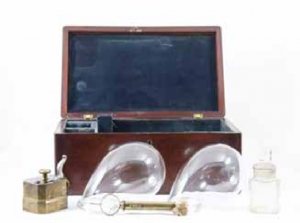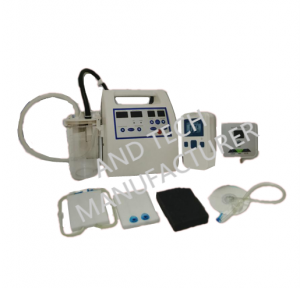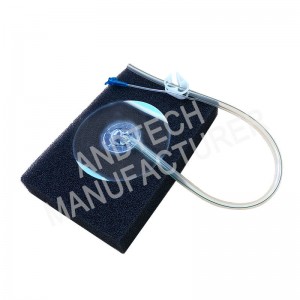1. When was NPWT invented?
Although the NPWT system was originally developed in the early 1990s, its roots can be traced back to the earliest civilizations. In Roman times, it was believed that wounds would heal better if they were sucked with their mouths.
According to records, in 1890,Gustav Bier has developed a cupping system that includes glasses and tubes of various shapes and sizes. Doctors can use this system to extract secretions from wounds in various body parts of the patient. In the current era, NPWT continues to have advantages in the healing of complex wounds.
Since then, NPWT has played an important role in medical treatment

2. How NPWT works?
Negative pressure wound therapy (NPWT) is a method of drawing out fluid and infection from a wound to help it heal. A special dressing (bandage) is sealed over the wound and a gentle vacuum pump is attached.
This therapy involves a special dressing (bandage), tubing, a negative pressure device, and canister to collect fluids.
Your healthcare providers will fit layers of foam dressing to the shape of the wound. The dressing will then be sealed with a film.
The film has an opening where a tube is attached. The tube leads to a vacuum pump and canister where fluids are collected. The vacuum pump can be set so that it is ongoing, or so it starts and stops intermittently.
The vacuum pump pulls fluid and infection from the wound. This helps pull the edges of the wound together. It also helps the wound heal by promoting the growth of new tissue.
When needed, antibiotics and saline can be pushed into the wound.
3. Why do I need it?
Doctor may recommend NPWT if patients have a burn, pressure ulcer, diabetic ulcer, chronic (long-lasting) wound, or injury. This therapy can help your wound heal faster and with fewer infections.
NPWT is a good choice for some patients, but not all. Doctor will decide if patients are a good candidate for this therapy based on your type of wound and your medical situation.
It's worth noting that using NPWT is also limited in scope. The NPWT system should not be used to treat wounds if the patient has the following symptoms:
1. Patients with coagulation disorders or blood diseases
2. Patients with severe hypoalbuminemia.
3. Cancer Ulcer Wounds
4. Active bleeding wounds
5. Other unsuitable clinical patients
6. Patients with severe diabetes
4. Why NPWT is better?
Protection
NPWT is a closed system that helps protect the wound bed from external contaminants. Without this, NPWT also maintains a perfect moisture balance in the wound for a better healing environment. To protect the wound by reducing the risk of returning to the inflammatory stage, the number of dressing changes needs to be reduced.
Healing
The wound healing time after using NPWT was noticeable, which healed the wound faster than traditional methods. The therapy promotes granulation formation, which reduces edema and creates new capillary beds.
Confidence
NPWT can be carried around, allowing the patient to move freely, increasing the patient's active time, and allowing them to live a better life with confidence. NPWT removes bacteria and excess exudate, maintaining a perfectly moist wound bed environment and promoting faster healing. With NPWT, wound care is available 24/7, reducing patient worry and burden.
5.What are the characteristics of the NPWT I use?
PVA medical sponge is a wet sponge, the material is safe, moderately soft and hard, non-toxic and non-irritating in inspection and certification; highly super absorbent.
PU sponge is a dry sponge, and polyurethane material is currently the best thermal insulation material in the world. It has advantages in the management of exudate, manifested in: high drainage capacity, especially suitable for severe exudate and infected wounds, promotes granulation tissue formation, and ensures uniform transmission pressure.
The NPWT machine can be used portable and can be carried with you to ensure the continuous cleaning of the wound. There are different suction modes to modify the treatment plan for different wounds.
6. I still want more Tips
How is the dressing changed?
Having your dressing changed regularly is very important to your healing.
How often?
In most cases, the dressing should be changed 2 to 3 times a week. If the wound is infected, the dressing may need to be changed more often.
Who changes it?
In most cases, the dressing will be changed by a nurse from your doctor’s office or a home health service. This person will be specially trained to change this type of dressing. In some cases, a caregiver, family member, or friend may be trained to change the dressing.
What care needs to be taken?
The person changing your dressing needs to do these things:
Wash hands before and after each dressing change.
Always wear protective gloves.
If they have an open cut or skin condition, wait until it has healed before changing your dressing. In this case, another person should change your dressing.
Does it hurt?
Changing this type of dressing is similar to changing any other type of dressing. It may hurt a little, depending on the type of wound. Ask your healthcare providers for help with pain relief.
How long will it take to heal my wound? How long it takes your wound to heal depends on a number of factors. These can include your general health, the size and location of the wound, and your nutritional status. Ask your doctor what you should expect.
Can I take a bath?
No. Bath water can infect a wound. Also, the dressing on the wound can become loose if it’s held under water.
Post time: Oct-25-2022







